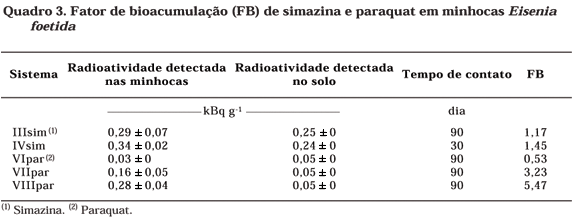Herbicides are normally applied directly onto the soil, where they enter in contact with soil organisms, among these with earthworms, whose metabolism can act on herbicide residues. Focusing on the earthworms Eisenia foetida as model we determined: dissipation of the 14C- herbicides Simazine and Paraquat as well as bioaccumulation in the animal tissues from soil treated with the recommended doses and with 10 and 100 times higher doses for paraquat. Earthworms and soil were analyzed by solvent extraction and radiometric techniques after 30 or 90 days of contact. The earthworms altered the dissipation of simazine, because 100% of radiocarbon was recovered from soil without earthworms, compared with 90% from soil with the animals. Furthermore, Bioaccumulation Factors (FB) of 1.45 and 1.17 were determined in their tissues after an exposition to contaminated soil for 30 and 90 days, respectively, which shows the accumulation of simazine and/or its metabolites. On the other hand, the earthworms did not alter the behavior of paraquat, although an increasing bioaccumulation of its residues and/or its metabolites was detected (FB of 0.5; 3.2 and 5.5, respectively, from the recommended and the 10 and 100-fold agricultural doses).
14C-herbicides; persistence; bioaccumulation



